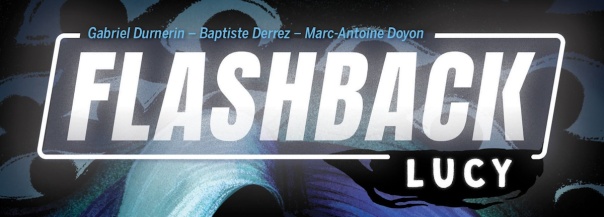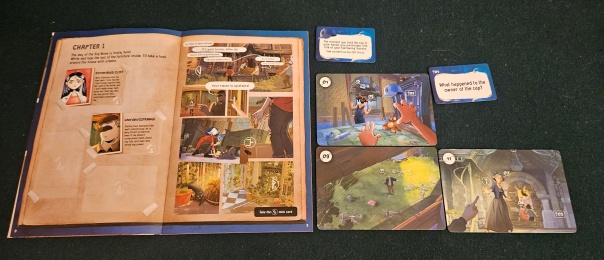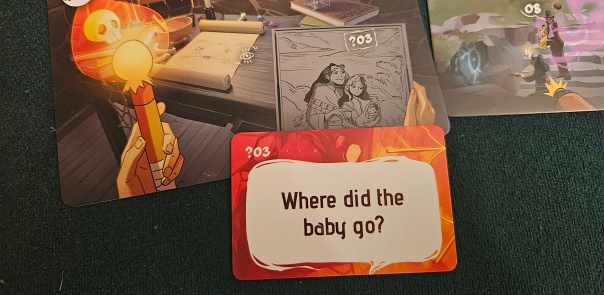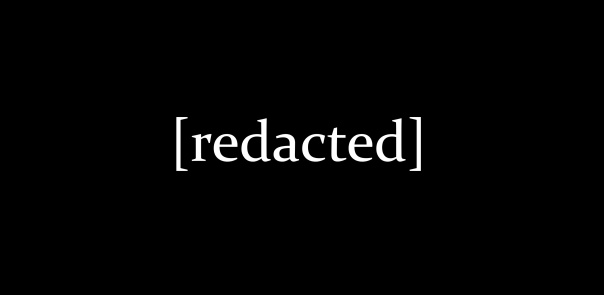Lucy in the Floorboards with Shadows
Flashback: Lucy is designed to be impossible to talk about. Remember the first time anybody played a legacy game? How there were sealed envelopes and boxes? That moment players were instructed to look under the insert? Nowadays I reflexively check under there any time a game seems like it might be hiding something from me.
I won’t spill whether something lurks under the insert of Flashback: Lucy, but there are discoveries to be made. The phrase “delight and surprise” is overused, but that’s precisely the emotion the team behind Flashback: Lucy managed to dredge from this leathery old sack.
Meet Lucy. Lucy is a fifteen-year old girl with social anxiety that very likely arises from her mystical ability to touch an object and relive the final scenes of the one who held it last. Terrible. Useful.
The game introduces Lucy through a few comic panels. It’s a brisk introduction, providing only the barest sketch of who Lucy and her father are and why they’ve come to inherit an obviously haunted mansion. These hasty steps come across as necessarily limited by the format — the rulebook is also the storybook and it’s thin on both counts, with a sealed final page that not so much hints as bellows that there’s a hidden ending for the most astute vision walkers to uncover.
These panels also introduce the broad strokes of the gameplay. This is a mystery game, one told through images on cards, text on smaller cards, and teased out through leading questions. Those questions are your objective. At the end of each chapter you’ll tackle them one by one, checking your answers against the upside-down print at the back of the rulebook, like you’re a kid at the dentist solving the riddles in a Highlights magazine. Somebody needs to handle the cards, pulling the proper selections from the proper decks and arranging them on the table according to some internal logic, but otherwise this is a largely passive experience. The box says it’s suitable for one to four players, but you could play with a thousand onlookers and nothing would change.
Little by little, Lucy experiences her visions. Her powers are more potent than the comic first indicates. She not only witnesses one vision but many, leaping between the still images imprinted on the retinas, mirrors, and camera lenses of everybody in the area. One final moment becomes a dozen interlaced perspectives. It’s a vivid conceit, one that takes full advantage of the “stillness” of a board game, the limitation of images frozen in time, while still drawing a larger picture. Whose eyes are you looking out from? That, too, is often part of the mystery.
It’s inventive, there’s no denying it. The designers find plenty of space to play, introducing new concepts with each chapter. Naturally, discussing them too openly would spoil the experience.
Except there’s one problem — Flashback: Lucy tells you the answers to each of its puzzles. It spells out precisely how to interact with each chapter’s gimmick. When there’s a hidden cavity beneath the floorboards, it doesn’t let you stomp around and realize there’s a hollow sound under the carpet. No. It puts up a sign that says, “Hey, inspector, there’s something under your feet right now.”
It’s frankly baffling. Where a more confident game would allow players to uncover the house’s mysteries at their own pace, Flashback: Lucy falls victim to its own desire to let nothing go overlooked. Within moments of starting the second chapter, the cards spell out how to reveal a series of hidden clues. The concept is incredibly cool, deploying a trick I have yet to see anywhere else. But rather than letting players muddle through some cryptic clues and unveil the chapter’s secrets through trial and error, you’re told outright to… well, again, that’s a spoiler. But the game hands it to you without a moment’s hesitation, robbing players of what might have been a profound realization.
That same lack of confidence is evident elsewhere, too. Flashback: Lucy can’t help itself. Don’t get me wrong, even at its toughest this wouldn’t have been some Agatha Christie-esque puzzle box. Each chapter revolves around one gimmick, a few hidden details in the pictures, and that’s it. At its most troublesome, the game might have taken a few extra minutes to suss out. With the solutions served up, we completed all four chapters in under 90 minutes, with a full set of “perfect” answers and access to the hidden ending. I’m not sure we ever solved anything.
It reminds me of that time as a kid when my uncle gifted me a copy of the Prima Games strategy guide to Myst. I’d watched him play it for maybe an hour and wondered aloud at its waterlogged forests and soaring treehouses, but had yet to touch my hands to the keyboard. A week later, he dropped by my house and handed me the whole book of solutions. I spent an afternoon poring over its secrets, marveling at the construction of that world. And then, when I at last acquired a copy of the game for myself, those wondrous sights were wholly stripped of their power. I’d seen behind the curtain and unraveled it thread by thread.
Flashback: Lucy is like reading the guide for a puzzle game before actually trying your hand at the puzzle. It still produces a pleasant enough hour or two. Reading the story, looking at the pictures, answering some basic questions — it’s all good stuff. It delighted and surprised me with its cleverness.
But it also spoiled that cleverness. It stole away any potential to discover it for myself. What remains is a husk, a mystery solved by some egotist murderer for the sake of a detective he doesn’t trust to follow the clues to their natural conclusion. There are no lightbulbs to click on, no masks to tear away. Lucy sees mysterious visions of the past. Sadly, the answers to those mysteries appear in her peripheral vision. Even her ghosts don’t trust her. No wonder she’s so anxious.
(If what I’m doing at Space-Biff! is valuable to you in some way, please consider dropping by my Patreon campaign or Ko-fi.)
A complimentary copy was provided.
Posted on June 19, 2024, in Board Game and tagged Board Games, Flashback: Lucy, Scorpion Masqué. Bookmark the permalink. 6 Comments.




It’s always a bummer when creators do not trust their audience. Do you think the issues could be fixed with a redacted story/rulebook that blocks out the mystery-sapping hints?
It might help, certainly. This is still a rather slight game, though, so I’m not sure it would solve the problem entirely.
This seems like the opposite of City of Six Moons, where the designer not only trusts her players to solve the mystery, but trusts them to be mature enough to handle not solving the mystery. I hope this designer is able to tweak this into something more challenging in the future. Maybe openable hint packets.
I very nearly contrasted this with City of Six Moons before deciding it would be premature. In that case, I fear Amabel may have trusted us (me) too much! Because I’m terrible at figuring out what’s going on with that game.
If you do figure out City of the Six Moons, then please write a non-spoiler review in that game’s symbols.
At this point, I can basically assign a score and that’s it.